Attached files
| file | filename |
|---|---|
| 8-K - 8-K - REGIONS FINANCIAL CORP | rf2018-06x06ir.htm |
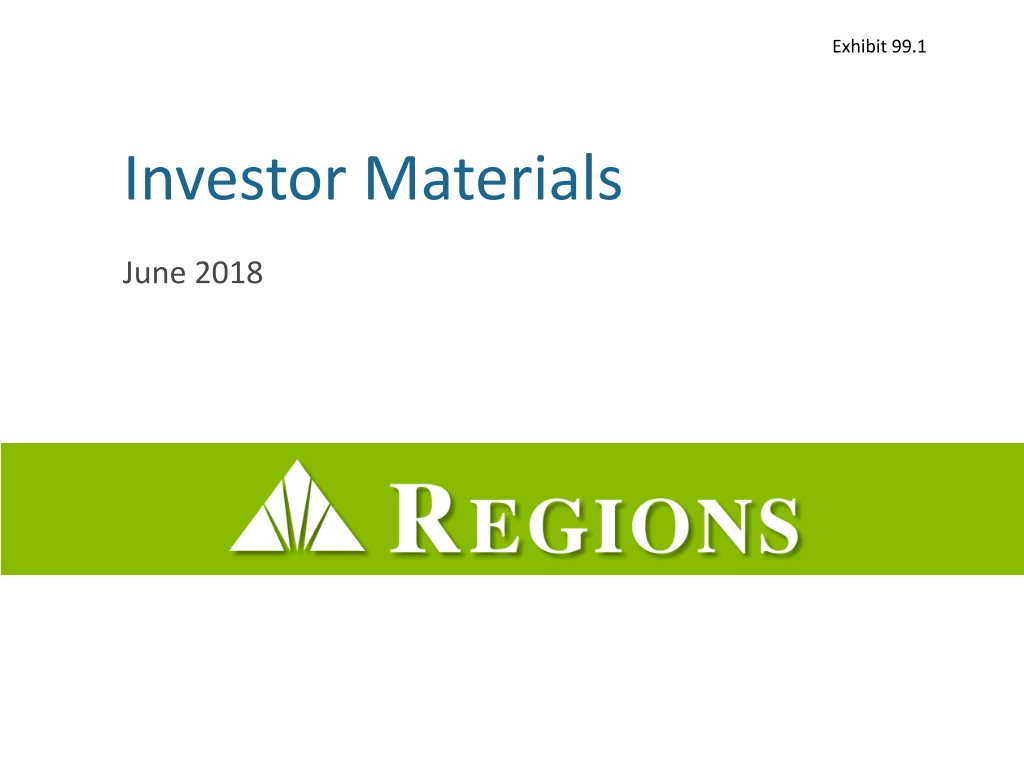
Exhibit 99.1 Investor Materials June 2018

Table of contents Topic Page # Profile 3-10 Net Interest Income and Asset Sensitivity 11-16 Fee Income and Efficiencies 17-20 Balance Sheet 21-27 Credit 28-30 Innovation and Technology 31-36 Capital and Liquidity 37-41 Long-term Targets and 2017 Expectations 42-45 Governance and Social Responsibility 46-48 Non-GAAP and Forward Looking Statements 49-54 2

PROFILE 3

Our banking franchise Regions aims to be the premier regional financial institution in America Ranked 16th Nationally in Total Deposits(2) Line of Business Coverage Branch Locations by State (1) Alabama – 204 Louisiana – 98 Corporate Banking Birmingham, Alabama • Arkansas – 75 Mississippi – 117 • Business Capital • Capital Markets Florida – 314 Missouri – 57 • Dealer Finance Georgia – 119 North Carolina – 6 • Equipment Finance • Government/Institutional Illinois – 46 South Carolina – 24 • Specialized Industry • Institutional Services Indiana – 50 Tennessee – 210 • Insurance Iowa – 8 Texas – 71 • Private Wealth • Real Estate Corporate Banking Kentucky – 11 • Commercial Banking (1) Full Service branches as of 3/31/2018 (2) Source: SNL Financial as of 06/30/2017 4

Strength of our markets Market Rank in Core States(1) High Market Share(1) ($ in Billions) #2 #6 Top MSAs Deposits Market Rank Birmingham, AL $11.2 1 #2 #1 Nashville, TN $7.6 2 #5 Tampa, FL $5.1 4 Memphis, TN $4.2 2 #7 New Orleans, LA $3.1 4 80% Jackson, MS $3.0 2 Mobile, AL $2.3 1 Knoxville, TN $2.2 3 80% of total deposits are in our core states Baton Rouge, LA $1.9 4 Alabama - Mississippi - Florida Louisiana - Tennessee - Arkansas Montgomery, AL $1.7 1 Data as of 6/30/17; Source: SNL Financial (1) Market rank by state based on FDIC deposit data as of 6/30/17 5

Footprint positioning Characterized by high growth markets(1) ($ in Billions) ($ in Billions) '18-'23 Population Growth '18-'23 Population Growth Top MSAs Deposits Top MSAs Deposits 8.3% 7.7% Houston, TX $1.4 Dallas, TX $1.0 8.2% 7.7% Orlando, FL $1.8 Destin, FL $0.9 6.9% 7.5% Nashville, TN $7.6 Sarasota, FL $0.6 6.7% 6.9% Tampa, FL $5.1 Fairhope, AL $0.9 6.6% 6.9% Miami, FL $4.2 Jacksonville, FL $1.0 6.5% 6.3% Atlanta, GA $3.7 Pensacola, FL $1.2 4.3% 6.1% Huntsville, AL $1.6 Panama City, FL $0.5 3.7% 5.4% New Orleans, LA $3.1 Ocala, FL $0.7 3.7% 4.5% Indianapolis, IN $1.7 Augusta, GA $0.6 3.6% 3.9% Knoxville, TN $2.2 Chattanooga, TN $1.3 National Average: 3.5% National Average: 3.5% Data as of 6/30/17; Source: SNL Financial (1) FDIC deposit data as of 6/30/17 6

Strength of our markets - our 15 state footprint Of all new jobs Of all US port trade 43% created in the US 61% tonnage(4) traveling since 2009 were through ports in our (1) in our footprint footprint Of all US light 58% vehicle production Of non-durable goods is within our 50% manufacturing occurs (5) footprint(2) in our footprint Of all U.S. population 49% growth between Of the total US GDP is 2009-2017 occurred 36% within our footprint(5) within our footprint(3) 1. Source: Bureau of Labor Statistics through March 2017; Data pulled May 2, 2017 2. Source: Automotive News Light Vehicle Production by state for 2016 3. Source: U.S. Census Bureau 4. Based on Total Domestic Shipping Tonnage by state; U.S. Army Corps of Engineers, as of 2015 7 5. Bureau of Economic Analysis; non-durable goods is as a percent of the non-durable good subcomponent of GDP, as of 2015

Regions receives top honors 8

Strategic priorities 9

Strategic initiatives supporting company priorities ® 10
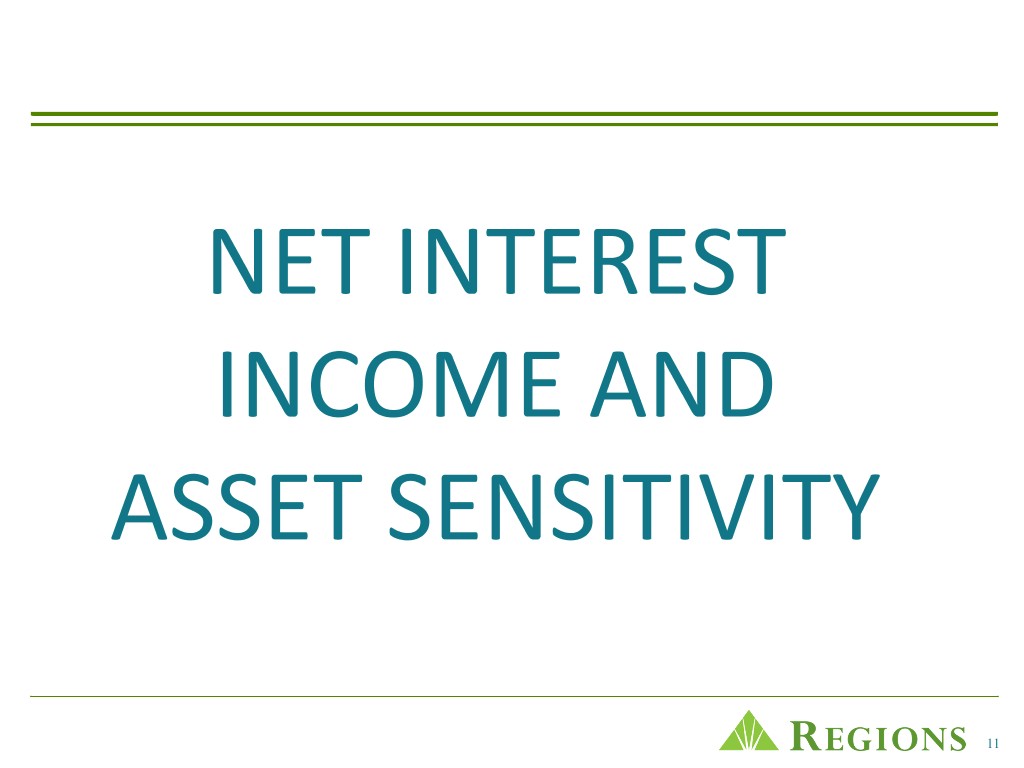
NET INTEREST INCOME AND ASSET SENSITIVITY 11
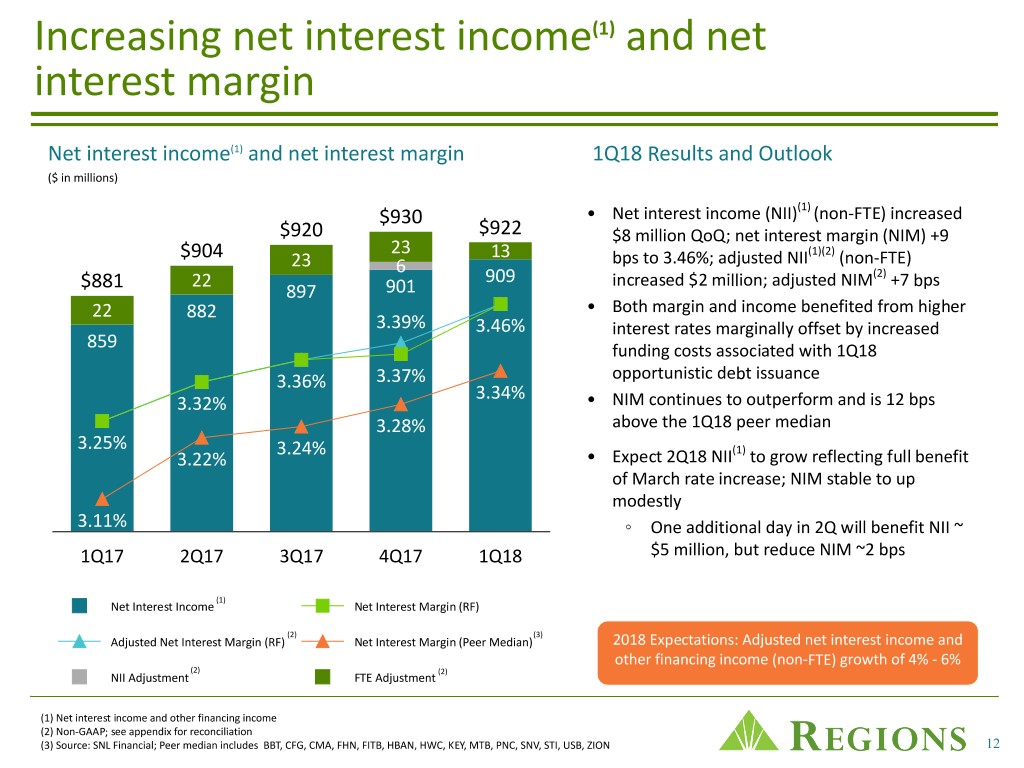
Increasing net interest income(1) and net interest margin Net interest income(1) and net interest margin 1Q18 Results and Outlook ($ in millions) (1) $930 • Net interest income (NII) (non-FTE) increased $920 $922 $8 million QoQ; net interest margin (NIM) +9 $904 23 13 (1)(2) 23 6 bps to 3.46%; adjusted NII (non-FTE) $881 22 909 increased $2 million; adjusted NIM(2) +7 bps 897 901 22 882 • Both margin and income benefited from higher 3.39% 3.46% interest rates marginally offset by increased 859 funding costs associated with 1Q18 3.36% 3.37% opportunistic debt issuance 3.34% 3.32% • NIM continues to outperform and is 12 bps 3.28% above the 1Q18 peer median 3.25% 3.24% (1) 3.22% • Expect 2Q18 NII to grow reflecting full benefit of March rate increase; NIM stable to up modestly 3.11% ◦ One additional day in 2Q will benefit NII ~ 1Q17 2Q17 3Q17 4Q17 1Q18 $5 million, but reduce NIM ~2 bps (1) Net Interest Income Net Interest Margin (RF) (2) (3) Adjusted Net Interest Margin (RF) Net Interest Margin (Peer Median) 2018 Expectations: Adjusted net interest income and other financing income (non-FTE) growth of 4% - 6% (2) (2) NII Adjustment FTE Adjustment (1) Net interest income and other financing income (2) Non-GAAP; see appendix for reconciliation (3) Source: SNL Financial; Peer median includes BBT, CFG, CMA, FHN, FITB, HBAN, HWC, KEY, MTB, PNC, SNV, STI, USB, ZION 12

Interest rate risk exposure (as of March 31, 2018) Portfolio Compositions • Naturally asset sensitive balance sheet Assets Other Liabilities poised to benefit from rising interest 15% rates Deposits • 47% of loans are floating rate, Securities $123B 91% 20% $107B Borrowings (1) Loans including loan hedges 7% 65% • $29B of net contractual floating Other rate exposure(1)(2)(3) 2% • Middle and long-term sensitivity (1)(2) (1) primarily driven by execution of Loans Deposits Wholesale Borrowings fixed-rate lending strategies and Time Fixed 7% reinvestment of fixed-rate Fixed 20% 53% Non-Interest securities; diminished impact from IB Checking, Bearing $97B Money Market premium amortization unless rate $80B Checking $8B & Savings levels decline substantially Floating 38% 55% 47% • Predominantly funded (~90%) by Floating deposit franchise, comprised 80% mostly of smaller account, (1)(2)(3) consumer balances; 45% is fixed Contractual Floating Rate Exposure ($ in billions) rate (non-interest bearing or time) $22.2B $18.1B • Loan hedges(1) used at the margin to $11.0B protect earnings under low rates, while $11.0B allowing for NII to expand as rates rise $4.2B $2.2B • Deposit betas were roughly 54% through $1.7B $0B the last cycle and 13% so far this cycle(4), $(0.5)B both at the lower end of peers FF/Prime 1M Libor 3M Libor FF/Prime 1M Libor 3M Libor FF/Prime 1M Libor 3M Libor Assets Liabilities Net Exposure (1) Including balance sheet hedges ($7.825B receive fixed loan swaps, $3.4B received fixed debt swaps) (2) ARM mortgage loans are included as floating rate loans (3) Excluding deposits, which are primarily management priced (4) Last rising rate cycle measured from 2Q04 – 2Q07; current rising rate cycle measured from 3Q15 – 1Q18 13

Interest rate risk assumptions (as of March 31, 2018) Standard Interest Rate Risk Scenario Assumptions Baseline Scenario +100 bps Standard Shock Scenario +100bps parallel, instantaneous shock applied to Market Interest Rates Current implied forward rates current implied forward rates Full year adjusted average loans expected to grow Full year adjusted average loans expected to grow Loan Balance Growth low single digits(1) low single digits(1) Full year average deposits expected to grow low Full year average deposits expected to grow low single digits(2); ~$3B ending remixing from Non-Int (2) Deposit Balance Growth/ Mix single digits Bearing to Time (consistent with historical observations) New Business Loan Spreads Stable at current levels Stable at current levels Ramp up from ~40% to ~60% (non-linear model based on history; higher end of range occurring in large rate shocks >+100bps over longer time horizon Deposit Re-pricing Betas Increasing in 2018 to a full year beta of ~35%(5) >12mo) 2018 Full Year NII Growth 4% - 6% Baseline Scenario +$114mm Assumption Sensitivity Analysis (3)(4) +$166 ($ in millions) +$135 +$140 +$114 +$93 +$85 +$88 +$74 -$3B Lower Additional $3B Deposit +5% Deposit -1% Loan Growth +100 bps +1% Loan -5% Deposit +200 bps Rate Deposit Balances Remixing ($6B Total) Beta (Avg) Standard Scenario Growth (Avg) Beta Shock Scenario (1) Growth expectations exclude the impact of third-party indirect-vehicle portfolio and sale of residential mortgage loans in 1Q18 (2) Growth expectations exclude the impact of brokered and Wealth Institutional Services deposits (3) Impacts of stresses to standard shock scenario are applied independently; not cumulative (4) Including balance sheet hedges ($7.825B receive fixed loan swaps, $3.4B received fixed debt swaps) 14 (5) Deposit beta utilizes 4Q17 rates as a starting point

Deposit advantage Expected to continue (2) Deposits by Customer Type(1) 1Q18 vs. 3Q15 Change in Interest Bearing Deposit Costs (Retail vs. Business) Peer #1 10bps 1Q18, ($ in billions) Peer #2 11bps Institutional Private RF 16bps (3) (3) Wealth Services Peer #3 16bps $8 $1 Peer #4 21bps Peer #5 21bps Peer #6 22bps Consumer Peer #7 23bps $28 Segment Corporate Peer #8 25bps $57 Segment Peer #9 27bps Peer #10 29bps Peer #11 33bps Other Peer #12 34bps Segment(3) Peer #13 46bps $1 Peer #14 47bps • Retail deposits consist of consumer and private wealth • Over 45% of our consumer low-cost deposit dollars have been accounts and represent 68% of total deposits customers for over 10 years • Business deposits consist of corporate, institutional and • Through the current rising interest rate cycle, total cumulative other accounts and represent 32% of total deposits deposit betas of only 13% • 37% of total average 1Q18 deposits are non-interest bearing • Cumulative consumer retail deposit betas near zero deposits • Cumulative commercial deposit betas ~39% 2018 Expectations: Full-year average deposits expected to grow in the low single digits, excluding brokered and Wealth Institutional Services deposits(3). (1) Average Balances (2) Source: SNL Financial; Peers includes BBT, CFG, CMA, FHN, FITB, HBAN, HWC, KEY, MTB, PNC, SNV, STI, USB and ZION. (3) Private Wealth Management and Institutional Services deposits are combined into the Wealth Management Segment. Total Other segment deposits consists primarily of brokered deposits. A break-out of these components is provided in the Company's quarterly Earnings Supplement. 15

Deposit composition and pricing (as of March 31, 2018) Interest bearing deposit betas(1) Deposit funding composition(1)(2) 40% ) Peer 6 8 1 100% Q 1 Peer 14 89% 89% 90% 90% 90% 90% 90% - 86% 90% 83% 83% 83% 84% 85% 5 82% 1 79% 30% 80% Peer median = 85% Q Peer 8 3 ( Peer 3 a 70% t e Peer median = 6.0bps Peer Peer 4 B 60% t Peer 7 s o 50% C 20% Peer median = 18.5% t i Peer 10 48% s 40% o Peer 1 Peer 2 p Peer 11 40% e Peer 13 Peer 5 30% D 33% 32% 33% g RF 27% n 26% Peer median = 26% i 20% 23% 24% r 20% 22% 22% 22% e 10% 28% 26% B 10% - Peer 9 Peer 12 t s e r 0% e P P P P P P P P P R P P P P P t ee ee ee ee ee ee ee ee ee F ee ee ee ee ee n r 1 r 2 r 3 r 4 r 5 r 6 r 7 r 8 r 9 r 1 r 1 r 1 r 1 r 1 I 0 1 2 3 4 0% 0 2 4 6 8 10 NIB to Total Liabilities Deposits to Total Liabilities 1Q18 vs. 4Q17 Change in Interest-Bearing Deposit Cost (bps) • Regions' predominantly deposit funded balance sheet, which includes an attractive mix of low cost core deposits, provides for a competitive funding advantage against the peer set ◦ 89% of liability funding is comprised of deposits, 4% above the peer group median ◦ 37% of the deposit base is in non-interest bearing accounts, the third highest in the peer group • This advantage is evidenced in the current rising rate cycle (3Q15 to 1Q18) through Regions' 13% cumulative deposit beta versus the peer median of 18.5% (1) All peer data used is from the respective earnings report and has not been adjusted for M&A activity (2) Calculated using average balances in Q1 2018. Peers include: BBT, CFG, CMA, FHN, FITB, HBAN, HWC, KEY, MTB, PNC, SNV, STI, USB, ZION 16

FEE INCOME AND EFFICIENCIES 17

Well-positioned for non-interest income growth Non-interest income 1Q18 Results and Outlook ($ in millions) $516 $507 • Non-interest income decreased $9 million; $490 adjusted non-interest income(1) decreased $474 $482 10 4 $3 million QoQ 6 9 Wealth - invest services 171 171 ◦ Decline in capital markets and card & 169 Mortgage 168 175 ATM fees partially offset by increase in Capital markets mortgage income Other ◦ 1Q18 includes $6 million increase to 106 104 the value of an equity investment and 104 Wealth - IM&T 104 103 a $7 million net gain on the sale of Card and ATM LIHTC investments offset by $4 million 59 58 net impairment charges related to the 56 57 Service charges 58 value of operating lease assets 64 65 Selected items (1) 61 57 55 56 50 32 38 35 41 40 32 36 38 16 15 15 14 17 1Q17 2Q17 3Q17 4Q17 1Q18 2018 Expectations: Adjusted non-interest income growth of 3%-6% (1) Non-GAAP; see appendix for reconciliation 18
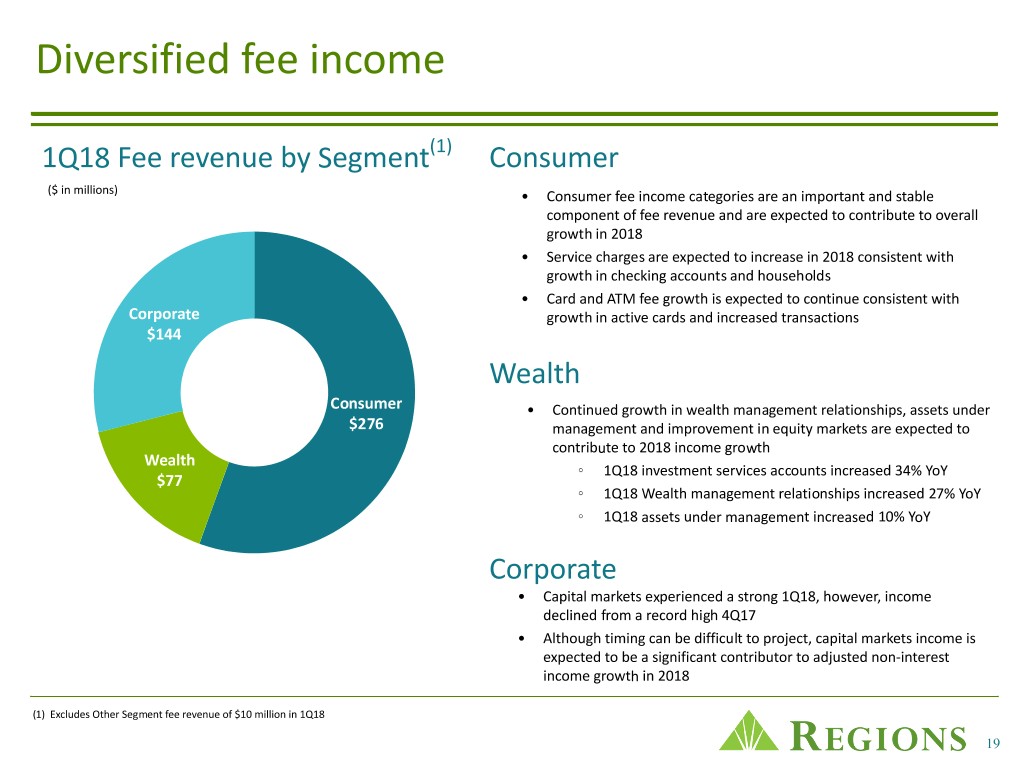
Diversified fee income 1Q18 Fee revenue by Segment(1) Consumer ($ in millions) • Consumer fee income categories are an important and stable component of fee revenue and are expected to contribute to overall growth in 2018 • Service charges are expected to increase in 2018 consistent with growth in checking accounts and households • Card and ATM fee growth is expected to continue consistent with Corporate growth in active cards and increased transactions $144 Wealth Consumer • Continued growth in wealth management relationships, assets under $276 management and improvement in equity markets are expected to contribute to 2018 income growth Wealth ◦ 1Q18 investment services accounts increased 34% YoY $77 ◦ 1Q18 Wealth management relationships increased 27% YoY ◦ 1Q18 assets under management increased 10% YoY Corporate • Capital markets experienced a strong 1Q18, however, income declined from a record high 4Q17 • Although timing can be difficult to project, capital markets income is expected to be a significant contributor to adjusted non-interest income growth in 2018 (1) Excludes Other Segment fee revenue of $10 million in 1Q18 19

Prudently managing expenses Non-interest expenses 1Q18 Results and Outlook ($ in millions) $920 • $884 Non-interest expense decreased $36 $875 51 (1) $843 $853 million; adjusted non-interest expense 10 22 decreased $7 million QoQ 5 6 61.9% 62.3% ◦ Decrease in Visa class B shares 60.8% 60.5% 60.5% expense and FDIC assessments, partially offset by modest increases 865 869 862 838 847 in salaries and benefits and professional fees • 1Q18 efficiency ratio 61.9%; adjusted efficiency ratio(1) stable at 60.5% 1Q17 2Q17 3Q17 4Q17 1Q18 • 1Q18 effective tax rate was 23.6% Adjusted Non-Interest Expense(1) Selected Items(1) Adjusted efficiency Ratio(1) 2018 Expectations: Full-year adjusted non-interest expense relatively stable; adjusted efficiency ratio <60%, adjusted operating leverage of 3%-5%, and effective tax rate in the 20-22% range (1) Non-GAAP; see appendix for reconciliation 20

BALANCE SHEET 21

Prudently managing loans Transitioning to growth Average loans and leases 1Q18 Results ($ in billions) $80.2 $80.1 $79.6 $79.5 $79.9 2.1 1.9 1.7 1.5 1.2 • Reported average loans increased modestly; Adjusted total (1) loans (1) adjusted average loans increased $620 78.1 78.2 77.9 78.0 78.7 Adjustments million QoQ ◦ Adjusted average consumer loans(1) 1Q17 2Q17 3Q17 4Q17 1Q18 increased $157 million; growth in residential mortgage, indirect vehicles, (1) Adjusted average loans and leases indirect-other consumer, and credit card ($ in billions) ◦ Average business loans increased $463 $78.1 $78.2 $77.9 $78.0 $78.7 29.2 29.2 29.6 29.8 30.1 million; solid C&I growth partially offset by Business Lending declines in owner-occupied commercial real Adjusted estate and investor real estate 48.9 49.0 48.3 48.2 48.6 Consumer Lending (1) 1Q17 2Q17 3Q17 4Q17 1Q18 (1) Non-GAAP; see appendix for reconciliation 22

Average loan composition Average consumer loans(1) Average business loans(1) ($ in billions) ($ in billions) Mortgage $14.0 CRE Mortgage - OO Indirect-Vehicles $6.1 $2.2 CRE Construction - $31.3B Indirect-Vehicles OO $0.3 Third-Party $1.1 Commercial and $48.6B IRE - Mortgage $3.9 Other $1.2 Indirect-Other $1.5 industrial $36.5 Credit Card $1.3 IRE - Construction $1.8 Home Equity $10.0 2018 Expectations: Full-year adjusted average loans expected to grow in the low single digits (1) Average balances for 1Q18. 23
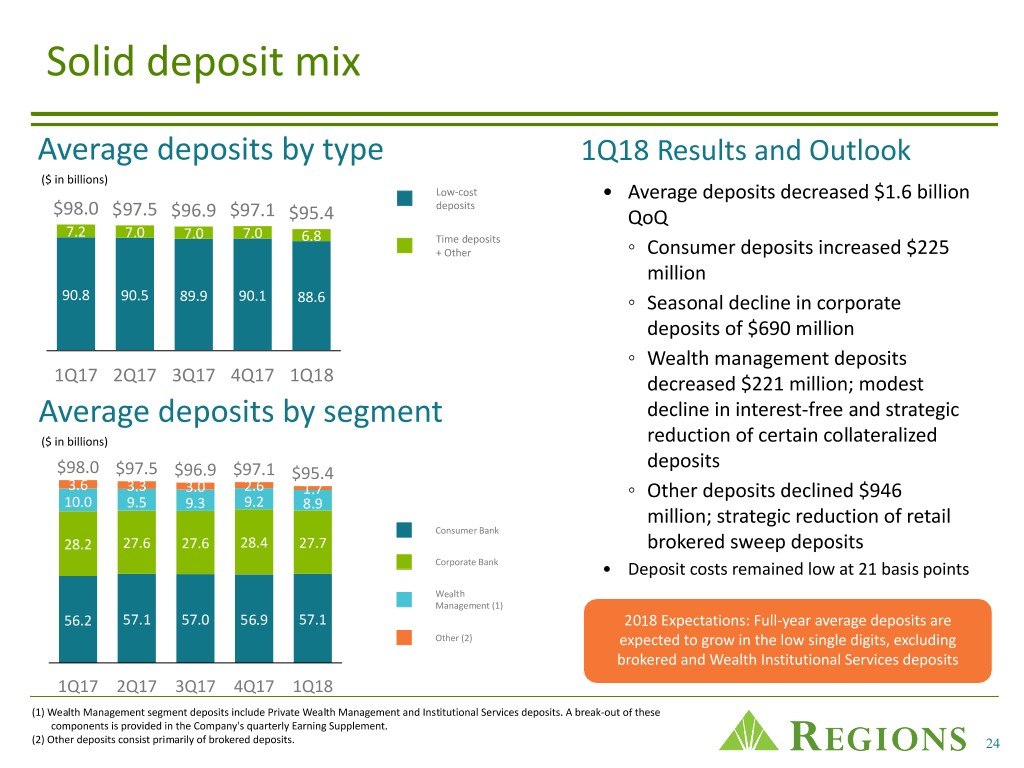
Solid deposit mix Average deposits by type 1Q18 Results and Outlook ($ in billions) Low-cost • Average deposits decreased $1.6 billion deposits $98.0 $97.5 $96.9 $97.1 $95.4 QoQ 7.2 7.0 7.0 7.0 6.8 Time deposits + Other ◦ Consumer deposits increased $225 million 90.8 90.5 89.9 90.1 88.6 ◦ Seasonal decline in corporate deposits of $690 million ◦ Wealth management deposits 1Q17 2Q17 3Q17 4Q17 1Q18 decreased $221 million; modest Average deposits by segment decline in interest-free and strategic ($ in billions) reduction of certain collateralized deposits $98.0 $97.5 $96.9 $97.1 $95.4 3.6 3.3 3.0 2.6 1.7 ◦ Other deposits declined $946 10.0 9.5 9.3 9.2 8.9 million; strategic reduction of retail Consumer Bank 28.2 27.6 27.6 28.4 27.7 brokered sweep deposits Corporate Bank • Deposit costs remained low at 21 basis points Wealth Management (1) 56.2 57.1 57.0 56.9 57.1 2018 Expectations: Full-year average deposits are Other (2) expected to grow in the low single digits, excluding brokered and Wealth Institutional Services deposits 1Q17 2Q17 3Q17 4Q17 1Q18 (1) Wealth Management segment deposits include Private Wealth Management and Institutional Services deposits. A break-out of these components is provided in the Company's quarterly Earning Supplement. (2) Other deposits consist primarily of brokered deposits. 24
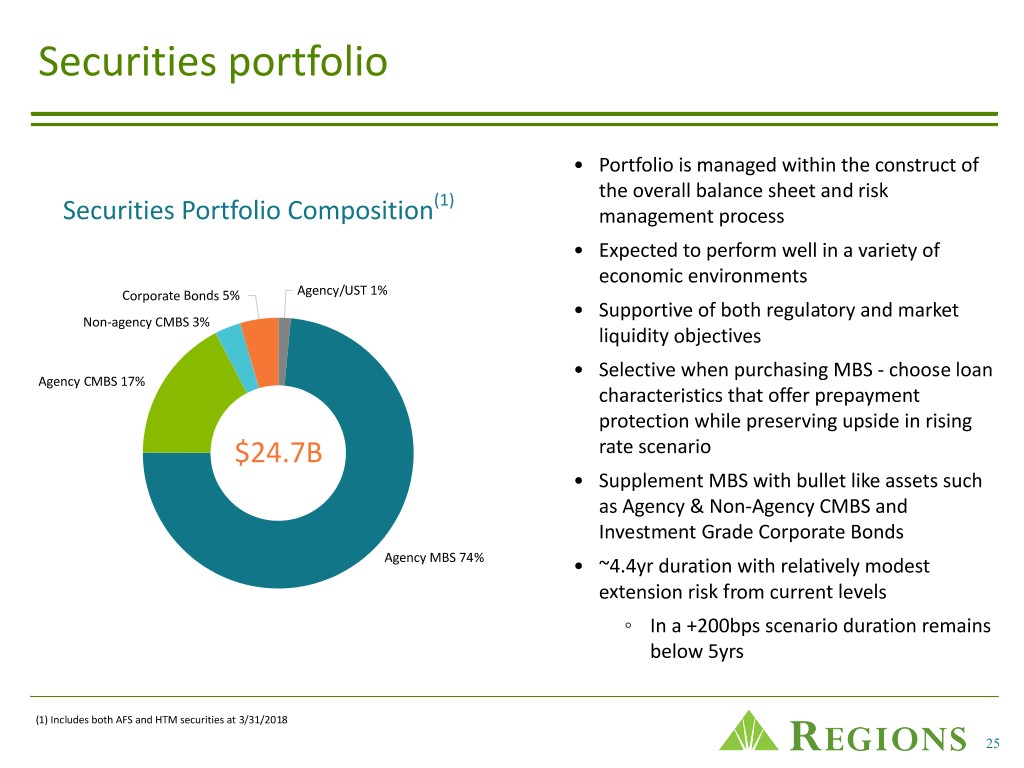
Securities portfolio • Portfolio is managed within the construct of (1) the overall balance sheet and risk Securities Portfolio Composition management process • Expected to perform well in a variety of economic environments Corporate Bonds 5% Agency/UST 1% • Supportive of both regulatory and market Non-agency CMBS 3% liquidity objectives • Selective when purchasing MBS - choose loan Agency CMBS 17% characteristics that offer prepayment protection while preserving upside in rising $24.7B rate scenario • Supplement MBS with bullet like assets such as Agency & Non-Agency CMBS and Investment Grade Corporate Bonds Agency MBS 74% • ~4.4yr duration with relatively modest extension risk from current levels ◦ In a +200bps scenario duration remains below 5yrs (1) Includes both AFS and HTM securities at 3/31/2018 25

Balance sheet optimization Historical Debt Profile • Regions actively manages its debt profile in response to balance ($ in billions) sheet changes and growth 7.04% 6.94% 6.58% 6.45% dynamics 6.21% 6.14% 5.85% 5.89% • Regions' relatively modest 5.42% wholesale funding footprint 4.79% 4.81% $8.90 positions Regions well to utilize 4.35% $8.65 $8.31 $8.00 available funding sources to $7.80 4.75 $7.75 4.15 $7.31 5.25 $7.35 protect the deposit base 4.25 4.25 $6.70 2.60 3.85 4.25 $6.00 $6.00 • In 1Q 2018, Regions issued $900 $5.31 2.20 2.58% 2.50 2.50 million of senior unsecured bank 3.00 5.40 4.50 4.50 notes $3.16 4.15 3.55 3.50 3.50 3.50 3.50 3.16 3.06 3.06 ◦ Reduces FDIC assessment 2.31 expense ◦ Improves diversified 1Q15 2Q15 3Q15 4Q15 1Q16 2Q16 3Q16 4Q16 1Q17 2Q17 3Q17 4Q17 1Q18 funding base • At 3/31/18, weighted average Unsecured Secured (FHLB) interest rate for FHLB advances was 1.8% and weighted average Total Debt as a % of Assets of remaining maturities of 0.9 years Note: Balances exclude valuation adjustments on hedged long-term debt and capital lease obligations. 26
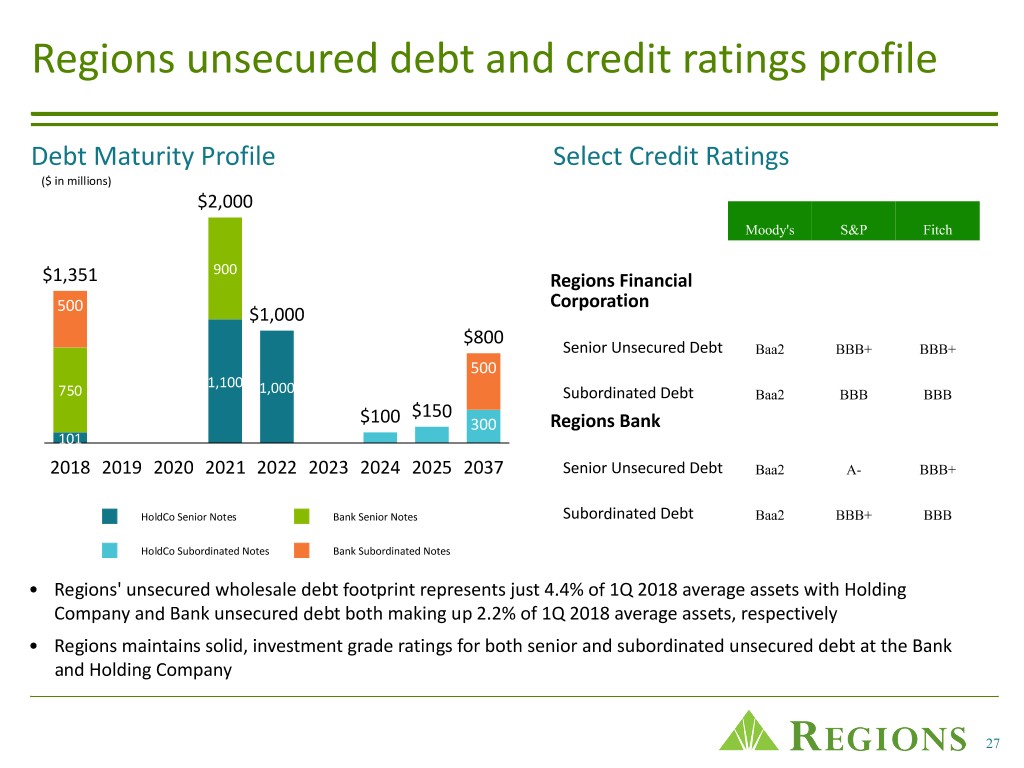
Regions unsecured debt and credit ratings profile Debt Maturity Profile Select Credit Ratings ($ in millions) $2,000 Moody's S&P Fitch 900 $1,351 Regions Financial Corporation 500 $1,000 $800 Senior Unsecured Debt Baa2 BBB+ BBB+ 500 1,100 750 1,000 Subordinated Debt Baa2 BBB BBB $150 $100 300 Regions Bank 101 2018 2019 2020 2021 2022 2023 2024 2025 2037 Senior Unsecured Debt Baa2 A- BBB+ HoldCo Senior Notes Bank Senior Notes Subordinated Debt Baa2 BBB+ BBB HoldCo Subordinated Notes Bank Subordinated Notes • Regions' unsecured wholesale debt footprint represents just 4.4% of 1Q 2018 average assets with Holding Company and Bank unsecured debt both making up 2.2% of 1Q 2018 average assets, respectively • Regions maintains solid, investment grade ratings for both senior and subordinated unsecured debt at the Bank and Holding Company 27

CREDIT 28
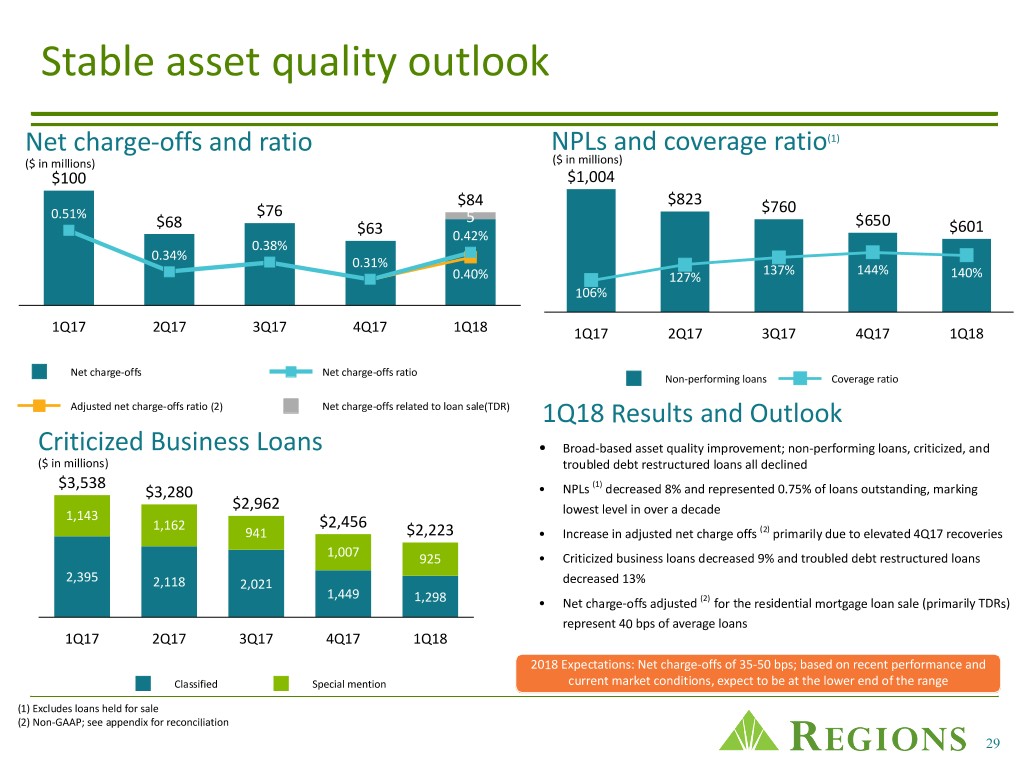
Stable asset quality outlook Net charge-offs and ratio NPLs and coverage ratio(1) ($ in millions) ($ in millions) $100 $1,004 $84 $823 $760 0.51% $76 5 $68 $650 $601 $63 0.42% 0.38% 0.34% 0.31% 137% 144% 0.40% 127% 140% 106% 1Q17 2Q17 3Q17 4Q17 1Q18 1Q17 2Q17 3Q17 4Q17 1Q18 Net charge-offs Net charge-offs ratio Non-performing loans Coverage ratio Adjusted net charge-offs ratio (2) Net charge-offs related to loan sale(TDR) 1Q18 Results and Outlook Criticized Business Loans • Broad-based asset quality improvement; non-performing loans, criticized, and ($ in millions) troubled debt restructured loans all declined $3,538 (1) $3,280 • NPLs decreased 8% and represented 0.75% of loans outstanding, marking $2,962 1,143 lowest level in over a decade 1,162 $2,456 941 $2,223 • Increase in adjusted net charge offs (2) primarily due to elevated 4Q17 recoveries 1,007 925 • Criticized business loans decreased 9% and troubled debt restructured loans 2,395 2,118 2,021 decreased 13% 1,449 1,298 • Net charge-offs adjusted (2) for the residential mortgage loan sale (primarily TDRs) represent 40 bps of average loans 1Q17 2Q17 3Q17 4Q17 1Q18 2018 Expectations: Net charge-offs of 35-50 bps; based on recent performance and Classified Special mention current market conditions, expect to be at the lower end of the range (1) Excludes loans held for sale (2) Non-GAAP; see appendix for reconciliation 29
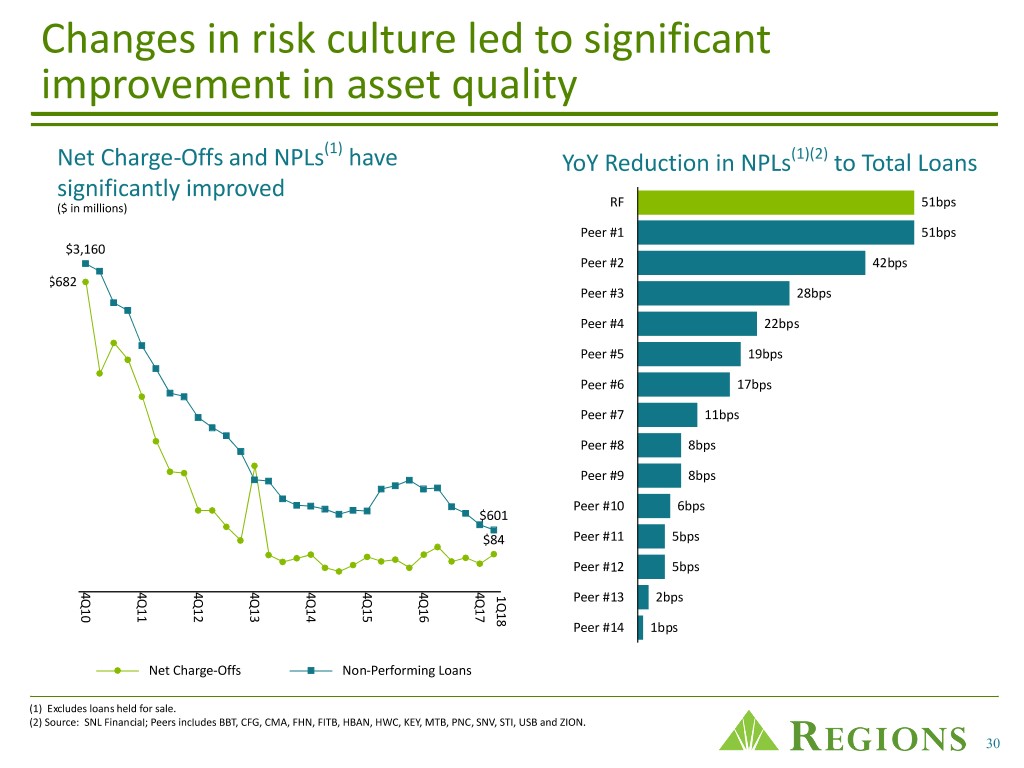
Changes in risk culture led to significant improvement in asset quality (1) Net Charge-Offs and NPLs have YoY Reduction in NPLs(1)(2) to Total Loans significantly improved ($ in millions) RF 51bps Peer #1 51bps $3,160 Peer #2 42bps $682 Peer #3 28bps Peer #4 22bps Peer #5 19bps Peer #6 17bps Peer #7 11bps Peer #8 8bps Peer #9 8bps Peer #10 6bps $601 $84 Peer #11 5bps Peer #12 5bps 4 4 4 4 4 4 4 4 1Q18 Q Q Q Q Q Q Q Q Peer #13 2bps 1 1 1 1 1 1 1 1 0 1 2 3 4 5 6 7 Peer #14 1bps Net Charge-Offs Non-Performing Loans (1) Excludes loans held for sale. (2) Source: SNL Financial; Peers includes BBT, CFG, CMA, FHN, FITB, HBAN, HWC, KEY, MTB, PNC, SNV, STI, USB and ZION. 30

INNOVATION & TECHNOLOGY 31

Simplify and Grow: making it easier for customers and associates Goal: • Achieve sustainable, long-term growth • Deliver a great customer experience at every touch point: digital and in-person • Become more efficient and effective across the enterprise • Appeal to the next generation of customer Why: • Customer expectations for fast, easy and now are growing • Pace of technology change has accelerated driven by the smart phone • Banking industry undergoing transformational change 32

Simplify and Grow A three year journey Making Banking Easier Organization Simplification • Digitization • Organizational structure review • Loan process • Spans and layers review • Account opening • Streamline committees and decision • Streamline credit process; more making digital; faster response Revenue Growth Efficiency Improvements • Faster launch of new initiatives • Robotics and artificial intelligence • Advanced analytics to drive next • Shared services best customer offers • Branch and other facility • Channel optimization consolidations • Digitization • Outsourcing 33

Simplify and Grow Progress Update Initial Efficiency and Revenue Review Accomplishments • Announced organizational changes to Through the initial review streamline structure 30% opportunities identified ◦ 1Q18 FTE down 3% YoY represent ~70% expense savings and ~30% revenue • Entered into an agreement to sell 70% growth opportunities Regions Insurance Group ◦ Improved efficiency ratio ~80 basis points • Announced plans to further consolidate Initiatives in Process branch network ~30-40 in 2018 • Targeted de novos planned in key Artificial Intelligence growth markets ~20 in 2018 ◦ St. Louis ◦ Houston Process Automation ◦ Atlanta • Sold $254 million of primarily troubled debt restructured (TDR) residential Spans and Layers mortgage loans 34

Making banking easier for our customers through digitization Biometric and mobile based ZELLE® (expanded P2P solution) interactions across channels with differentiation Partnering with Digital Eco System Mobile-friendly applications for Strategic partnerships with FinTech deposit accounts and credit cards OMNI DIGITAL AT Modernized iTreasury and Wealth Pre-approved digital loan offers CHANNEL CORE Management (SEI) platforms Digital commercial loan experience Digital Marketing leveraging nCino CUSTOMER CENTRIC Touch ID and facial recognition Regions LockItSM for mobile login ENHANCED CUSTOMER Improved push notification and Advanced Know Your Customer SECURITY INTERACTIONS customer alerts (KYC) technologies Increase in self-service capabilities User Behavior Analytics 35

All efforts focused on CUSTOMER JOURNEYS Modern execution approach with 25% IT in Agile and DevOps Automation Artificial Intelligence • Rolled out pre-approved consumer • Cognitive capabilities in the loan offers within online banking contact center improving as well as eSignature capabilities customer experience and • Intelligent process automation efficiency through bots creating operational • Cognitive chat functionality in efficiencies in front and back development offices Data Management and Cloud Technologies Advanced Analytics • Data lake capabilities for all critical • More than 90% virtualization in data private cloud • Advanced analytics to improve • API strategy deployed to further lead management and location enable cloud integrations based analytics FOCUSED ON INCREASED SPEED TO MARKET 36
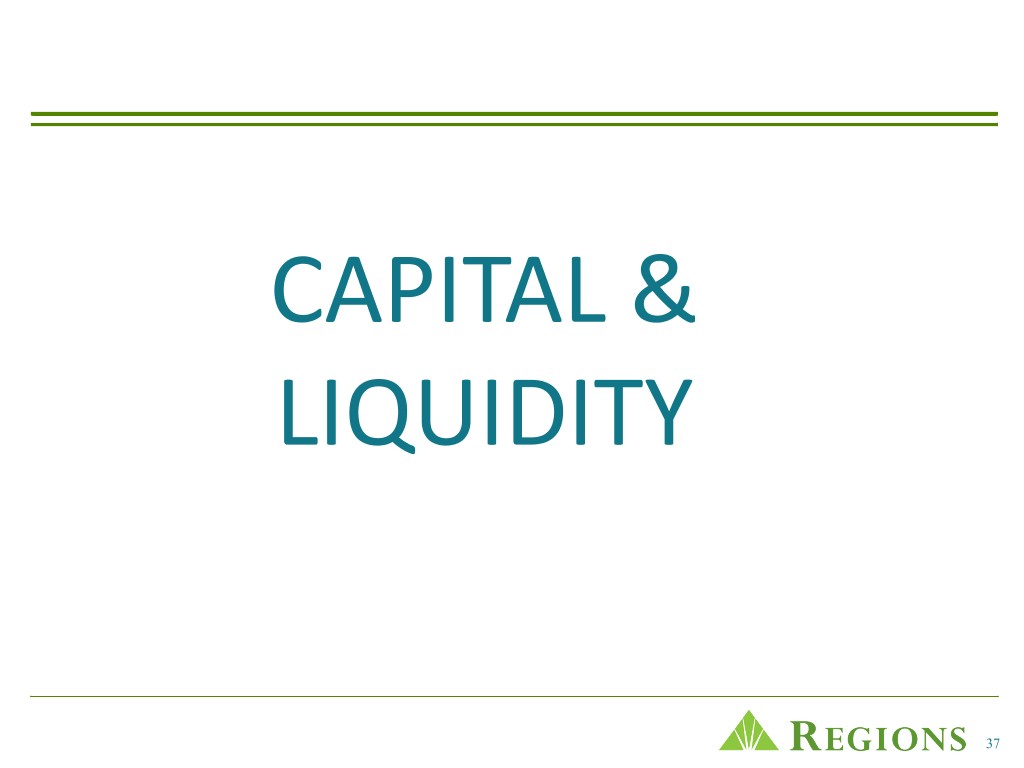
CAPITAL & LIQUIDITY 37

Solid liquidity Loan-to-deposit ratio(1) • Regions has a strong, core funded balance sheet resulting in a low loan- to-deposit ratio 82% 81% 83% 82% 80% • Future debt maturities are manageable and allow for efficient re-financing • Regions’ liquidity policy requires that the holding company maintain at least 18 months coverage of maturities, debt service and other cash needs • Management targets 24 months coverage • Bank wholesale funding requirements 1Q17 2Q17 3Q17 4Q17 1Q18 will be largely dictated by the relative performance of loan and deposit growth (1) Based on ending balances 38

Strong capital levels Basel III Common Equity Tier 1 Ratio(1) Capital Priorities Peer #1 12.2 Peer #2 12.0 Peer #3 11.2 RF 11.1 Peer #4 10.8 Peer #5 10.6 Peer #6 10.5 Peer #7 10.2 Peer #8 10.2 Peer #9 10.1 Peer #10 10.0 Peer #11 9.9 Peer #12 9.6 Peer #13 9.0 Peer #14 9.0 (1) Current quarter ratio is estimated. Ratios are as of 3/31/18. Peers includes BBT, CFG, CMA, FHN, FITB, HBAN, HWC, KEY, MTB, PNC, SNV, STI, USB and ZION. Source: SNL Financial 39

Robust capital returns Capital Returned to Shareholders • Remain committed to target CET1 ($ in millions) $1,645 ratio of 9.5% based on current risk in our balance sheet • Repurchased $235 million or 12.5 million shares of common stock $1,157 in 1Q18, and declared $101 million in dividends to common $927 1,275 shareholders • Subject to approval, sale of 839 insurance subsidiary is expected 623 $503 to close in 3Q18 and generate 256 $336 ~$300 million of additional capital; expected to be used to 370 235 247 304 318 repurchase shares 101 • Sufficient capital to support 2014 2015 2016 2017 2018 YTD organic growth, strategic investments, and a robust return Dividends Share Repurchases (1) to shareholders (1) Includes fees associated with open market share repurchases. 40

Solid total shareholder returns 1 Year(1) 3 Year(1) 5 Year(1) Peer #1 39.5 Peer #1 102.7 Peer #1 202.2 Peer #2 38.7 Peer #2 95.9 Peer #2 159.6 RF 34.7 Peer #3 94.7 Peer #3 133.4 Peer #3 34.3 RF 93.8 Peer #4 124.0 Peer #4 31.6 Peer #4 87.2 RF 121.2 Peer #5 29.7 Peer #5 69.6 Peer #5 116.7 Peer #6 29.6 Peer #6 62.6 Peer #6 103.9 Peer #7 23.4 Peer #7 60.9 Peer #7 102.8 Peer #8 22.2 Peer #8 60.2 Peer #8 100.5 Peer #9 21.8 Peer #9 51.4 Peer #9 90.1 Peer #10 13.8 Peer #10 45.2 Peer #10 83.4 Peer #11 12.0 Peer #11 44.3 Peer #11 82.8 Peer #12 11.8 Peer #12 42.8 Peer #12 76.8 Peer #13 10.9 Peer #13 33.0 Peer #13 60.2 Peer #14 0.5 Peer #14 24.4 Peer #14 — (1) Total shareholder return data as of 5/31/2018. Peers include BBT, CFG (Publicly traded as of 2015), CMA, FITB, HBAN, HWC, KEY, MTB, PNC, SNV, STI, USB, FHN and ZION. Source - Bloomberg 41

LONG-TERM TARGETS & 2018 EXPECTATIONS 42

Managing for long-term performance Opportunities to drive growth and efficiencies Asset Sensitivity Capital Return Significant funding advantage Capital sufficient for organic driven by low-cost deposit growth, strategic opportunities, base, accretive fixed-rate robust shareholder returns reinvestments Stable Asset Quality Efficiency Opportunities Broad-based credit metric Identify and execute additional improvements opportunities to increase revenues and reduce expenses through 43
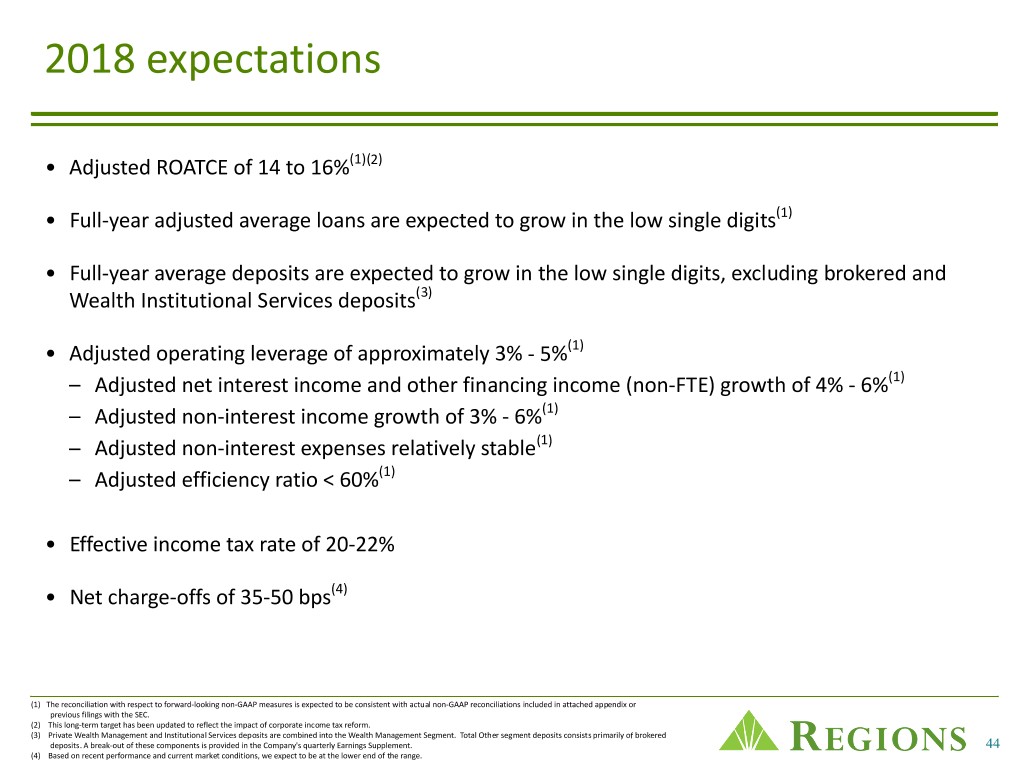
2018 expectations • Adjusted ROATCE of 14 to 16%(1)(2) • Full-year adjusted average loans are expected to grow in the low single digits(1) • Full-year average deposits are expected to grow in the low single digits, excluding brokered and Wealth Institutional Services deposits(3) • Adjusted operating leverage of approximately 3% - 5%(1) – Adjusted net interest income and other financing income (non-FTE) growth of 4% - 6%(1) – Adjusted non-interest income growth of 3% - 6%(1) – Adjusted non-interest expenses relatively stable(1) – Adjusted efficiency ratio < 60%(1) • Effective income tax rate of 20-22% • Net charge-offs of 35-50 bps(4) (1) The reconciliation with respect to forward-looking non-GAAP measures is expected to be consistent with actual non-GAAP reconciliations included in attached appendix or previous filings with the SEC. (2) This long-term target has been updated to reflect the impact of corporate income tax reform. (3) Private Wealth Management and Institutional Services deposits are combined into the Wealth Management Segment. Total Other segment deposits consists primarily of brokered deposits. A break-out of these components is provided in the Company's quarterly Earnings Supplement. 44 (4) Based on recent performance and current market conditions, we expect to be at the lower end of the range.

Long-term financial targets Strategic Initiatives 2016 - 2018 long-term financial targets Adjusted EPS growth of 12-15% (CAGR)(1) Adjusted efficiency ratio of <60%(1) Adjusted ROATCE 14-16%(1)(2) (1) Non-GAAP; the reconciliation with respect to forward-looking non-GAAP measures is expected to be consistent with actual non-GAAP reconciliations included in attached appendix or previous filings with the SEC. (2) Adjusted ROATCE target was reset from 12-14% to 14-16% for 2018 as a result of tax reform. 45

CORPORATE GOVERNANCE & CORPORATE SOCIAL RESPONSIBILITY 46

Corporate governance The company understands that good governance is the Engagement foundation of sustainable business and good decision making is • We take a long-term view of how we create value, and necessary for creating shareholder value over the long term. we take a similar approach to corporate governance shareholder engagement. • Regions is committed to constructive and meaningful Board of Directors communications with our shareholders and building Our Corporate Governance Principles affirm that the Board will ongoing relationships over time. seek members from diverse professional and demographic • We consider proper shareholder engagement to be a backgrounds, who combine a broad spectrum of experience and continuous relationship throughout the year through expertise with a reputation for integrity, to ensure the the Board in-person meetings, phone calls, and email updates. maintains an appropriate mix of skills and characteristics to meet • Engaging with our shareholders and soliciting their the needs of the company. points of view is critical to providing long-term value to Independence Diversity all of the company's stakeholders. Based on gender, ethnic, or sexual orientation Corporate Governance Enhancements • Enhanced board oversight for environmental and social responsibility 92% 38% • Adopted proxy access • Appointed a Chief Governance Officer, CSR analyst, and Associate Conduct Officer • Enhanced director recruitment criteria to consider diversity Compensation Principles • Strengthened the board self-evaluation process Create a balanced, performance-based compensation philosophy that • Brought more balance among our newer, mid-tenured, is properly aligned with strategic and financial objectives and supports and seasoned directors the company's risk appetite and tolerance. • Strengthened the company's corporate social responsibility function 47
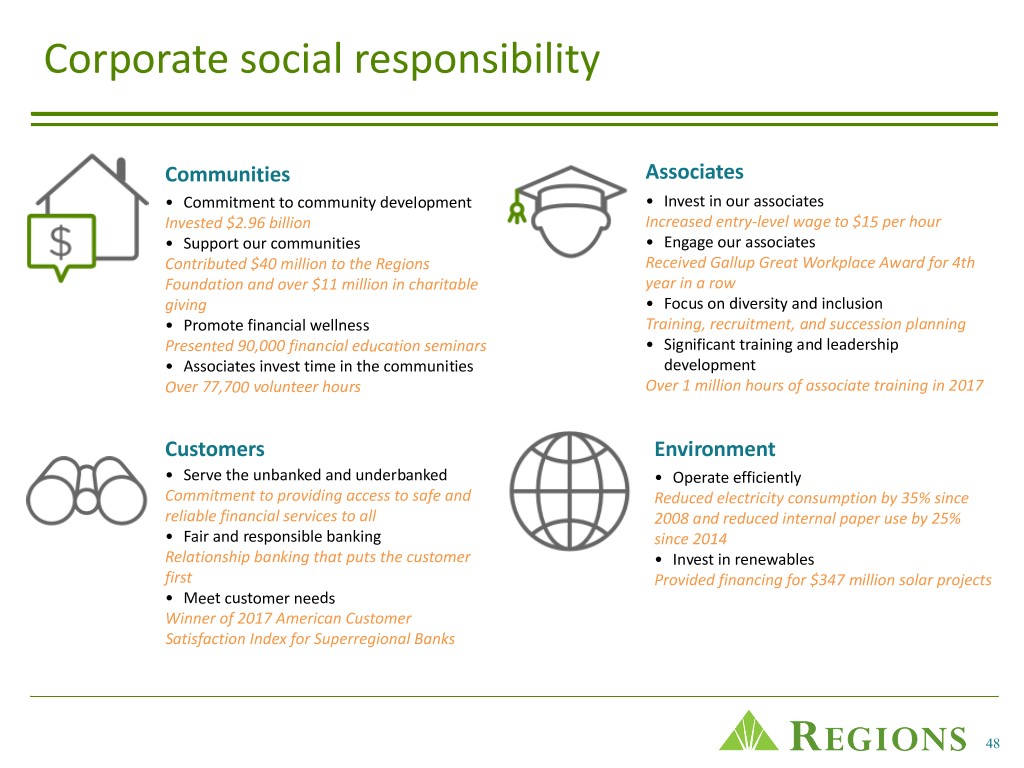
Corporate social responsibility Communities Associates • Commitment to community development • Invest in our associates Invested $2.96 billion Increased entry-level wage to $15 per hour • Support our communities • Engage our associates Contributed $40 million to the Regions Received Gallup Great Workplace Award for 4th Foundation and over $11 million in charitable year in a row giving • Focus on diversity and inclusion • Promote financial wellness Training, recruitment, and succession planning Presented 90,000 financial education seminars • Significant training and leadership • Associates invest time in the communities development Over 77,700 volunteer hours Over 1 million hours of associate training in 2017 Customers Environment • Serve the unbanked and underbanked • Operate efficiently Commitment to providing access to safe and Reduced electricity consumption by 35% since reliable financial services to all 2008 and reduced internal paper use by 25% • Fair and responsible banking since 2014 Relationship banking that puts the customer • Invest in renewables first Provided financing for $347 million solar projects • Meet customer needs Winner of 2017 American Customer Satisfaction Index for Superregional Banks 48

NON-GAAP & FORWARD LOOKING STATEMENTS 49

Non-GAAP reconciliation: NII/NIM, non-interest income/expense, operating leverage and efficiency ratio The table below and on the following page present computations of the net interest margin; efficiency ratio, which is a measure of productivity, generally calculated as non-interest expense divided by total revenue; and the fee income ratio, generally calculated as non-interest income divided by total revenue. Management uses these ratios to monitor performance and believes these measures provide meaningful information to investors. Non- interest expense (GAAP) is presented excluding certain adjustments to arrive at adjusted non-interest expense (non-GAAP), which is the numerator for the efficiency ratio. Net interest income and other financing income (GAAP) on a taxable-equivalent basis is presented excluding certain adjustments related to tax reform to arrive at adjusted net interest income and other financing income on a taxable-equivalent basis (non-GAAP). Non- interest income (GAAP) is presented excluding certain adjustments to arrive at adjusted non-interest income (non-GAAP), which is the numerator for the fee income ratio. Net interest income and other financing income on a taxable-equivalent basis and non-interest income are added together to arrive at total revenue on a taxable-equivalent basis. Adjustments are made to arrive at adjusted total revenue on a taxable-equivalent basis (non- GAAP), which is the denominator for the fee income and efficiency ratios. Regions believes that the exclusion of these adjustments provides a meaningful base for period-to-period comparisons, which management believes will assist investors in analyzing the operating results of the Company and predicting future performance. These non-GAAP financial measures are also used by management to assess the performance of Regions’ business. It is possible that the activities related to the adjustments may recur; however, management does not consider the activities related to the adjustments to be indications of ongoing operations. The table on the following page presents a computation of the operating leverage ratio (non-GAAP) which is the period to period percentage change in adjusted total revenue on a taxable-equivalent basis (non-GAAP) less the percentage change in adjusted non-interest expense (non-GAAP). Regions believes that presentation of these non-GAAP financial measures will permit investors to assess the performance of the Company on the same basis as that applied by management. Quarter Ended ($ amounts in millions) 3/31/2018 12/31/2017 9/30/2017 6/30/2017 3/31/2017 1Q18 vs. 4Q17 1Q18 vs. 1Q17 Non-interest expense (GAAP) A $ 884 $ 920 $ 853 $ 875 $ 843 $ (36) (3.9)% $ 41 4.9 % Adjustments: Contribution to Regions' charitable foundation associated with tax — (40) — — — 40 (100.0)% — NM Branch consolidation, property and equipment charges (3) (9) (5) (7) (1) 6 (66.7)% (2) 200.0 % Expenses associated with residential mortgage loan sale (4) — — — — (4) NM (4) NM Salary and employee benefits—severance charges (15) (2) (1) (3) (4) (13) NM (11) 275.0 % Adjusted non-interest expense (non-GAAP) B $ 862 $ 869 $ 847 $ 865 $ 838 $ (7) (0.8)% $ 24 2.9 % Net interest income and other financing income (GAAP) C $ 909 $ 901 $ 897 $ 882 $ 859 8 0.9 % 50 5.8 % Reduction in leveraged lease interest income resulting from tax reform — 6 — — — (6) (100.0)% — NM Adjusted net interest income and other financing income (non-GAAP) D $ 909 $ 907 $ 897 $ 882 $ 859 2 0.2 % 50 5.8 % Net interest income and other financing income (GAAP) $ 909 $ 901 $ 897 $ 882 $ 859 $ 8 0.9 % $ 50 5.8 % Taxable-equivalent adjustment 13 23 23 22 22 (10) (43.5)% (9) (40.9)% Net interest income and other financing income, taxable-equivalent basis E $ 922 $ 924 $ 920 $ 904 $ 881 $ (2) (0.2)% $ 41 4.7 % Reduction in leveraged lease interest income resulting from tax reform — 6 — — — (6) (100.0)% — NM Adjusted net interest income and other financing income, taxable equivalent basis (non-GAAP) F $ 922 $ 930 $ 920 $ 904 $ 881 $ (8) (0.9)% $ 41 4.7 % Net interest margin (GAAP) 3.46% 3.37% 3.36% 3.32% 3.25% Reduction in leveraged lease interest income resulting from tax reform — 0.02 — — — Adjusted net interest margin (non-GAAP) 3.46% 3.39% 3.36% 3.32% 3.25% Non-interest income (GAAP) G $ 507 $ 516 $ 482 $ 490 $ 474 $ (9) (1.7)% $ 33 7.0 % Adjustments: Securities (gains) losses, net — (10) (8) (1) — 10 (100.0)% — NM Leveraged lease termination gains (4) — (1) — — (4) NM (4) NM Gain on sale of affordable housing residential mortgage loans — — — (5) — — NM — NM Adjusted non-interest income (non-GAAP) H $ 503 $ 506 $ 473 $ 484 $ 474 $ (3) (0.6)% $ 29 6.1 % Total revenue C+G=I $ 1,416 $ 1,417 $ 1,379 $ 1,372 $ 1,333 $ (1) (0.1)% $ 83 6.2 % Adjusted total revenue (non-GAAP) D+H=J $ 1,412 $ 1,413 $ 1,370 $ 1,366 $ 1,333 $ (1) (0.1)% $ 79 5.9 % Total revenue, taxable-equivalent basis E $ 1,429 $ 1,440 $ 1,402 $ 1,394 $ 1,355 $ (11) (0.8)% $ 74 5.5 % Adjusted total revenue, taxable-equivalent basis (non-GAAP) F+H=L $ 1,425 $ 1,436 $ 1,393 $ 1,388 $ 1,355 $ (11) (0.8)% $ 70 5.2 % Operating leverage ratio (GAAP) K-A 0.6 % Adjusted operating leverage ratio (non-GAAP) L-B 2.3 % Efficiency ratio (GAAP) A/K 61.9% 63.9% 60.9% 62.8% 62.2% Adjusted efficiency ratio (non-GAAP) B/L 60.5% 60.5% 60.8% 62.3% 61.9% Fee income ratio (GAAP) G/K 35.5% 35.9% 34.3% 35.2% 35.0% Adjusted fee income ratio (non-GAAP) H/L 35.3% 35.3% 33.9% 34.9% 35.0% NM - Not Meaningful 50
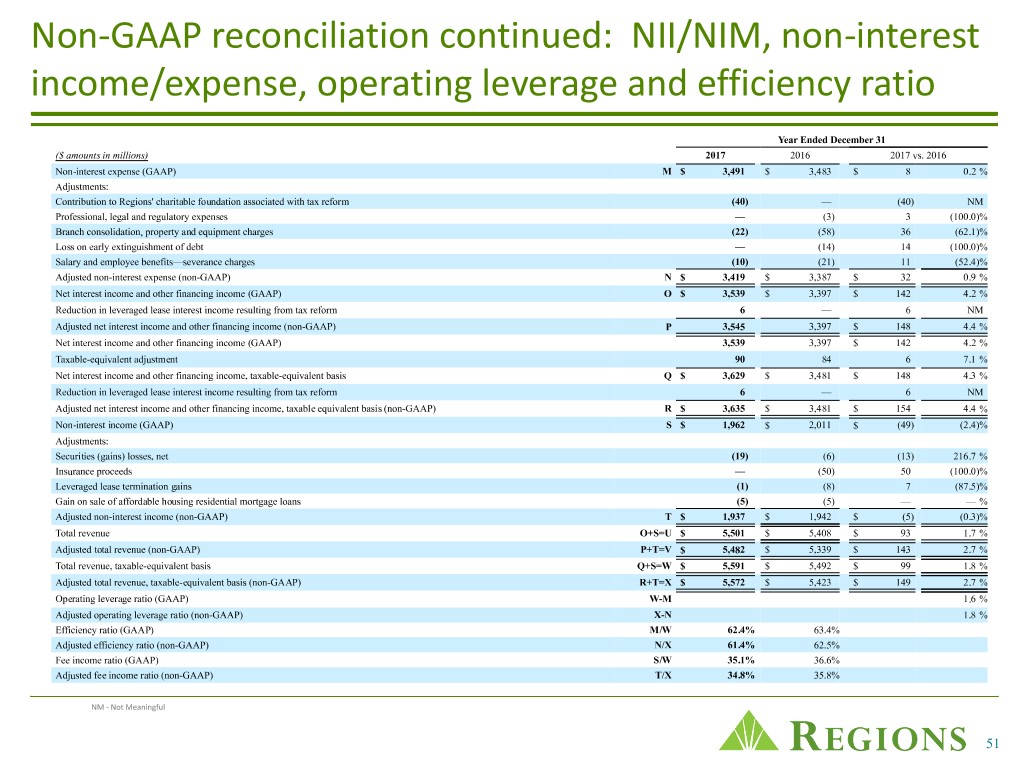
Non-GAAP reconciliation continued: NII/NIM, non-interest income/expense, operating leverage and efficiency ratio Year Ended December 31 ($ amounts in millions) 2017 2016 2017 vs. 2016 Non-interest expense (GAAP) M $ 3,491 $ 3,483 $ 8 0.2 % Adjustments: Contribution to Regions' charitable foundation associated with tax reform (40) — (40) NM Professional, legal and regulatory expenses — (3) 3 (100.0)% Branch consolidation, property and equipment charges (22) (58) 36 (62.1)% Loss on early extinguishment of debt — (14) 14 (100.0)% Salary and employee benefits—severance charges (10) (21) 11 (52.4)% Adjusted non-interest expense (non-GAAP) N $ 3,419 $ 3,387 $ 32 0.9 % Net interest income and other financing income (GAAP) O $ 3,539 $ 3,397 $ 142 4.2 % Reduction in leveraged lease interest income resulting from tax reform 6 — 6 NM Adjusted net interest income and other financing income (non-GAAP) P 3,545 3,397 $ 148 4.4 % Net interest income and other financing income (GAAP) 3,539 3,397 $ 142 4.2 % Taxable-equivalent adjustment 90 84 6 7.1 % Net interest income and other financing income, taxable-equivalent basis Q $ 3,629 $ 3,481 $ 148 4.3 % Reduction in leveraged lease interest income resulting from tax reform 6 — 6 NM Adjusted net interest income and other financing income, taxable equivalent basis (non-GAAP) R $ 3,635 $ 3,481 $ 154 4.4 % Non-interest income (GAAP) S $ 1,962 $ 2,011 $ (49) (2.4)% Adjustments: Securities (gains) losses, net (19) (6) (13) 216.7 % Insurance proceeds — (50) 50 (100.0)% Leveraged lease termination gains (1) (8) 7 (87.5)% Gain on sale of affordable housing residential mortgage loans (5) (5) — — % Adjusted non-interest income (non-GAAP) T $ 1,937 $ 1,942 $ (5) (0.3)% Total revenue O+S=U $ 5,501 $ 5,408 $ 93 1.7 % Adjusted total revenue (non-GAAP) P+T=V $ 5,482 $ 5,339 $ 143 2.7 % Total revenue, taxable-equivalent basis Q+S=W $ 5,591 $ 5,492 $ 99 1.8 % Adjusted total revenue, taxable-equivalent basis (non-GAAP) R+T=X $ 5,572 $ 5,423 $ 149 2.7 % Operating leverage ratio (GAAP) W-M 1.6 % Adjusted operating leverage ratio (non-GAAP) X-N 1.8 % Efficiency ratio (GAAP) M/W 62.4% 63.4% Adjusted efficiency ratio (non-GAAP) N/X 61.4% 62.5% Fee income ratio (GAAP) S/W 35.1% 36.6% Adjusted fee income ratio (non-GAAP) T/X 34.8% 35.8% NM - Not Meaningful 51

Non-GAAP reconciliation: adjusted average loans Regions believes adjusting total average loans for the impact of the first quarter 2018 residential first mortgage loan sale and the indirect vehicles third-party exit portfolio, provides a meaningful calculation of loan growth rates and presents them on the same basis as that applied by management. Adjusted Average Balances of Loans (non-GAAP) Average Balances ($ amounts in millions) 1Q18 4Q17 3Q17 2Q17 1Q17 1Q18 vs. 4Q17 1Q18 vs. 1Q17 Total consumer loans $ 31,272 $ 31,367 $ 31,327 $ 31,147 $ 31,234 $ (95) (0.3)% $ 38 0.1 % Less: Balances of residential first mortgage loans sold(1) 164 254 254 254 254 (90) (35.4)% (90) (35.4)% Less: Indirect—vehicles third-party 1,061 1,223 1,406 1,611 1,835 (162) (13.2)% (774) (42.2)% Adjusted total consumer loans (non-GAAP) $ 30,047 $ 29,890 $ 29,667 $ 29,282 $ 29,145 $ 157 0.5 % $ 902 3.1 % Total Loans $ 79,891 $ 79,523 $ 79,585 $ 80,110 $ 80,178 368 0.5 % (287) (0.4)% Less: Balances of residential first mortgage loans sold(1) 164 254 254 254 254 (90) (35.4)% (90) (35.4)% Less: Indirect—vehicles third-party 1,061 1,223 1,406 1,611 1,835 (162) (13.2)% (774) (42.2)% Adjusted total loans (non-GAAP) $ 78,666 $ 78,046 $ 77,925 $ 78,245 $ 78,089 $ 620 0.8 % $ 577 0.7 % (1) Adjustments to average loan balances assume a simple day-weighted average impact for the first quarter of 2018, and are equal to the ending balance of the residential first mortgage loans sold for the prior periods. NM - Not Meaningful. 52

Forward-looking statements Forward-Looking Statements This release may include forward-looking statements as defined in the Private Securities Litigation Reform Act of 1995, which reflect Regions’ current views with respect to future events and financial performance. Forward-looking statements are not based on historical information, but rather are related to future operations, strategies, financial results or other developments. Forward-looking statements are based on management’s expectations as well as certain assumptions and estimates made by, and information available to, management at the time the statements are made. Those statements are based on general assumptions and are subject to various risks, uncertainties and other factors that may cause actual results to differ materially from the views, beliefs and projections expressed in such statements. These risks, uncertainties and other factors include, but are not limited to, those described below: • Current and future economic and market conditions in the United States generally or in the communities we serve, including the effects of declines in property values, unemployment rates and potential reductions of economic growth, which may adversely affect our lending and other businesses and our financial results and conditions. • Possible changes in trade, monetary and fiscal policies of, and other activities undertaken by, governments, agencies, central banks and similar organizations, which could have a material adverse effect on our earnings. • The effects of a possible downgrade in the U.S. government’s sovereign credit rating or outlook, which could result in risks to us and general economic conditions that we are not able to predict. • Possible changes in market interest rates or capital markets could adversely affect our revenue and expense, the value of assets and obligations, and the availability and cost of capital and liquidity. • Any impairment of our goodwill or other intangibles, any repricing of assets, or any adjustment of valuation allowances on our deferred tax assets due to adverse changes in the economic environment, declining operations of the reporting unit, adverse consequences related to tax reform, or other factors. • The effect of changes in tax laws, including the effect of Tax Reform and any future interpretations of or amendments to Tax Reform, which may impact our earnings, capital ratios and our ability to return capital to shareholders. • Possible changes in the creditworthiness of customers and the possible impairment of the collectability of loans and leases, including operating leases. • Changes in the speed of loan prepayments, loan origination and sale volumes, charge-offs, loan loss provisions or actual loan losses where our allowance for loan losses may not be adequate to cover our eventual losses. • Possible acceleration of prepayments on mortgage-backed securities due to low interest rates, and the related acceleration of premium amortization on those securities. • Loss of customer checking and savings account deposits as customers pursue other, higher-yield investments, which could increase our funding costs. • Possible changes in consumer and business spending and savings habits and the related effect on our ability to increase assets and to attract deposits, which could adversely affect our net income. • Our ability to effectively compete with other financial services companies, some of whom possess greater financial resources than we do and are subject to different regulatory standards than we are. • Our inability to develop and gain acceptance from current and prospective customers for new products and services in a timely manner could have a negative impact on our revenue. • Our inability to keep pace with technological changes could result in losing business to competitors. • Changes in laws and regulations affecting our businesses, including legislation and regulations relating to bank products and services, as well as changes in the enforcement and interpretation of such laws and regulations by applicable governmental and self-regulatory agencies, which could require us to change certain business practices, increase compliance risk, reduce our revenue, impose additional costs on us, or otherwise negatively affect our businesses. • Our ability to obtain a regulatory non-objection (as part of the CCAR process or otherwise) to take certain capital actions, including paying dividends and any plans to increase common stock dividends, repurchase common stock under current or future programs, or redeem preferred stock or other regulatory capital instruments, may impact our ability to return capital to stockholders and market perceptions of us. • Our ability to comply with stress testing and capital planning requirements (as part of the CCAR process or otherwise) may continue to require a significant investment of our managerial resources due to the importance and intensity of such tests and requirements. • Our ability to comply with applicable capital and liquidity requirements (including, among other things, the Basel III capital standards and the LCR rule), including our ability to generate capital internally or raise capital on favorable terms, and if we fail to meet requirements, our financial condition could be negatively impacted. • The effects of any developments, changes or actions relating to any litigation or regulatory proceedings brought against us or any of our subsidiaries. • The costs, including possibly incurring fines, penalties, or other negative effects (including reputational harm) of any adverse judicial, administrative, or arbitral rulings or proceedings, regulatory enforcement actions, or other legal actions to which we or any of our subsidiaries are a party, and which may adversely affect our results. • Our ability to manage fluctuations in the value of assets and liabilities and off-balance sheet exposure so as to maintain sufficient capital and liquidity to support our business. 53

Forward-looking statements continued • Our ability to execute on our strategic and operational plans, including our ability to fully realize the financial and non-financial benefits relating to our strategic initiatives. • The risks and uncertainties related to our acquisition or divestiture of businesses. • The success of our marketing efforts in attracting and retaining customers. • Our ability to recruit and retain talented and experienced personnel to assist in the development, management and operation of our products and services may be affected by changes in laws and regulations in effect from time to time. • Fraud or misconduct by our customers, employees or business partners. • Any inaccurate or incomplete information provided to us by our customers or counterparties. • Inability of our framework to manage risks associated with our business such as credit risk and operational risk, including third-party vendors and other service providers, which could, among other things, result in a breach of operating or security systems as a result of a cyber attack or similar act or failure to deliver our services effectively. • Dependence on key suppliers or vendors to obtain equipment and other supplies for our business on acceptable terms. • The inability of our internal controls and procedures to prevent, detect or mitigate any material errors or fraudulent acts. • The effects of geopolitical instability, including wars, conflicts and terrorist attacks and the potential impact, directly or indirectly, on our businesses. • The effects of man-made and natural disasters, including fires, floods, droughts, tornadoes, hurricanes, and environmental damage, which may negatively affect our operations and/or our loan portfolios and increase our cost of conducting business. • Changes in commodity market prices and conditions could adversely affect the cash flows of our borrowers operating in industries that are impacted by changes in commodity prices (including businesses indirectly impacted by commodities prices such as businesses that transport commodities or manufacture equipment used in the production of commodities), which could impair their ability to service any loans outstanding to them and/or reduce demand for loans in those industries. • Our ability to identify and address cyber-security risks such as data security breaches, malware, “denial of service” attacks, “hacking” and identity theft, a failure of which could disrupt our business and result in the disclosure of and/or misuse or misappropriation of confidential or proprietary information; disruption or damage to our systems; increased costs; losses; or adverse effects to our reputation. • Our ability to realize our adjusted efficiency ratio target as part of our expense management initiatives. • Possible downgrades in our credit ratings or outlook could increase the costs of funding from capital markets. • The effects of problems encountered by other financial institutions that adversely affect us or the banking industry generally could require us to change certain business practices, reduce our revenue, impose additional costs on us, or otherwise negatively affect our businesses. • The effects of the failure of any component of our business infrastructure provided by a third party could disrupt our businesses; result in the disclosure of and/or misuse of confidential information or proprietary information; increase our costs; negatively affect our reputation; and cause losses. • Our ability to receive dividends from our subsidiaries could affect our liquidity and ability to pay dividends to stockholders. • Changes in accounting policies or procedures as may be required by the FASB or other regulatory agencies could materially affect how we report our financial results. • Other risks identified from time to time in reports that we file with the SEC. • Fluctuations in the price of our common stock and inability to complete stock repurchases in the time frame and/or on the terms anticipated. • The effects of any damage to our reputation resulting from developments related to any of the items identified above. The foregoing list of factors is not exhaustive. For discussion of these and other factors that may cause actual results to differ from expectations, look under the captions “Forward-Looking Statements” and “Risk Factors” of Regions’ Annual Report on Form 10- K for the year ended December 31, 2017, as filed with the SEC. The words “future,” “anticipates,” “assumes,” “intends,” “plans,” “seeks,” “believes,” “predicts,” “potential,” “objectives,” “estimates,” “expects,” “targets,” “projects,” “outlook,” “forecast,” “would,” “will,” “may,” “might,” “could,” “should,” “can,” and similar terms and expressions often signify forward-looking statements. We assume no obligation to update or revise any forward-looking statements that are made from time to time. Regions’ Investor Relations contact is Dana Nolan at (205) 264-7040; Regions’ Media contact is Evelyn Mitchell at (205) 264-4551. 54

® 55
